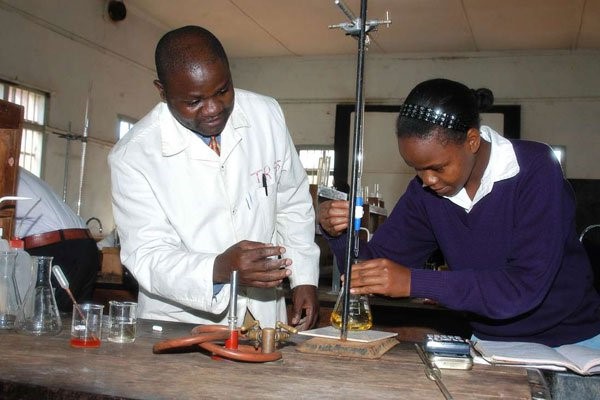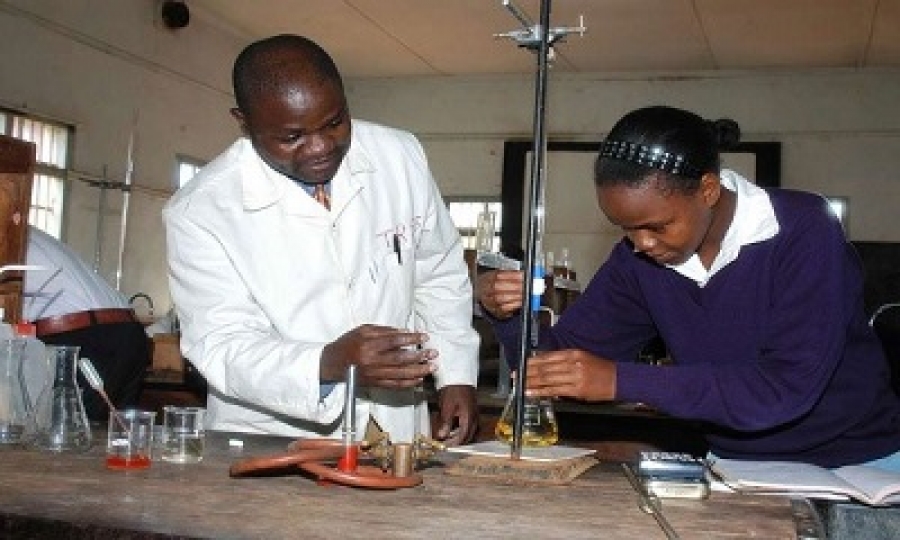Revealed: The force behind students’ performance in science subjects
SUNDAY AUGUST 6 2017
By OUMA WANZALA

A student from Temple Road Secondary School in Nyeri is assisted by her teacher during a chemistry lesson on May 12, 2010. PHOTO | JOSEPH KANYI | NATION MEDIA GROUP
Teachers play a key role in encouraging or discouraging students from taking up science subjects in secondary school, a new report has shown.
The study, conducted by the Centre for Mathematics, Science and Technology Education in Africa (CEMASTEA), shows teachers routinely advise students they consider weak not to take up science courses, when they should be encouraging them instead.
Other challenges identified include poor school infrastructure. Also, many schools were not proactive in entrenching the study of science. For instance, the study found that about 117 pieces of science equipment donated to one of the Science, Technology, Engineering and Mathematics (STEM) model schools last year had never been put to use.
“Let’s use this equipment,” said CEMASTEA Director, Mr Stephen Njoroge during the launch of the report last week.
Vision 2030 is premised on more students taking up mathematics and science in the hope that this will drive scientific inquiry and innovation. Launched last year, the STEM programme is expected to inspire learners to excel and pursue careers related to science and mathematics.
To address the challenges in science education in secondary schools, the government has embarked on an ambitious programme that seeks to update these subjects. The initiative, spearhead by CEMASTEA, seeks to fill the gaps by setting up STEM model schools across the country and changing the way the subjects are taught.
It also includes setting up of a special class dubbed ‘Makerspace’, where students pursuing the subjects will be able to innovate and enjoy a hands-on approach to teaching and learning. This is expected to enable students in the 102 schools to carry out activities such as robot building (Robotics), learning circuits and electricity with paper circuits, sewing, wood working and inventing.
The STEM programme was introduced in public schools last year, with one school being selected as a model in every county based on centrality, performance, STEM culture and leadership.
The survey also revealed how candidates in secondary schools have continued to perform below the mean score in science-related subjects in national examinations over the years. It shows that the overall school performance has grown gradually between 2006 and 2015. It is only in 2007 that the mean score in biology shot above the overall mean. In all the other STEM subjects, the mean score was below the overall mean, indicating that in most schools, mathematics and science were at the bottom.
The study was conducted last year and released last week during a workshop for the board of management and principals of 102 schools in Nakuru.
Latest from
- TEACHING AND LEARNING DURING COVID-19 PANDEMIC: INSIGHTS FROM SELECTED MATHEMATICS AND SCIENCE TEACHERS IN KENYA
- 3rd iTOYA OF THE YEAR AWARD
- CEMASTEA strive for the Best
- Mathematics and Science teachers undertake training dubbed: “Effective use of Learner-Centred strategies in Teaching and Learning”
- CS Amina Flags off the 3rd Batch of STEM Equipment Distribution

